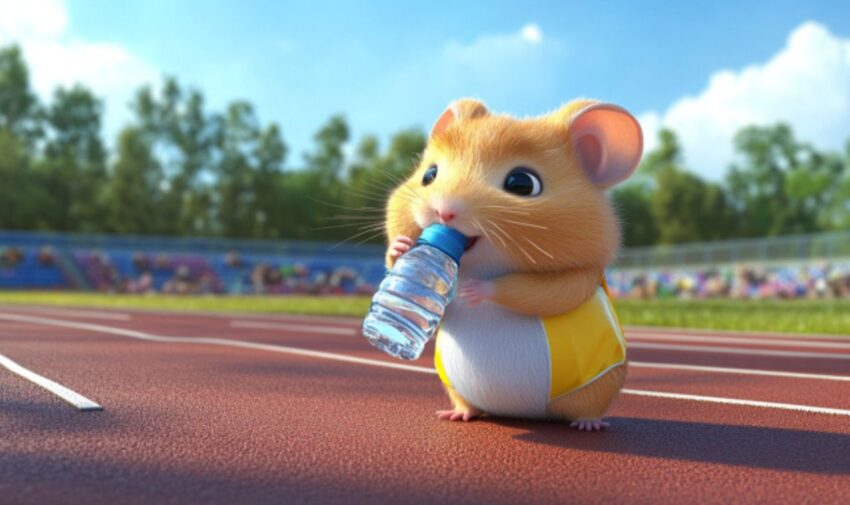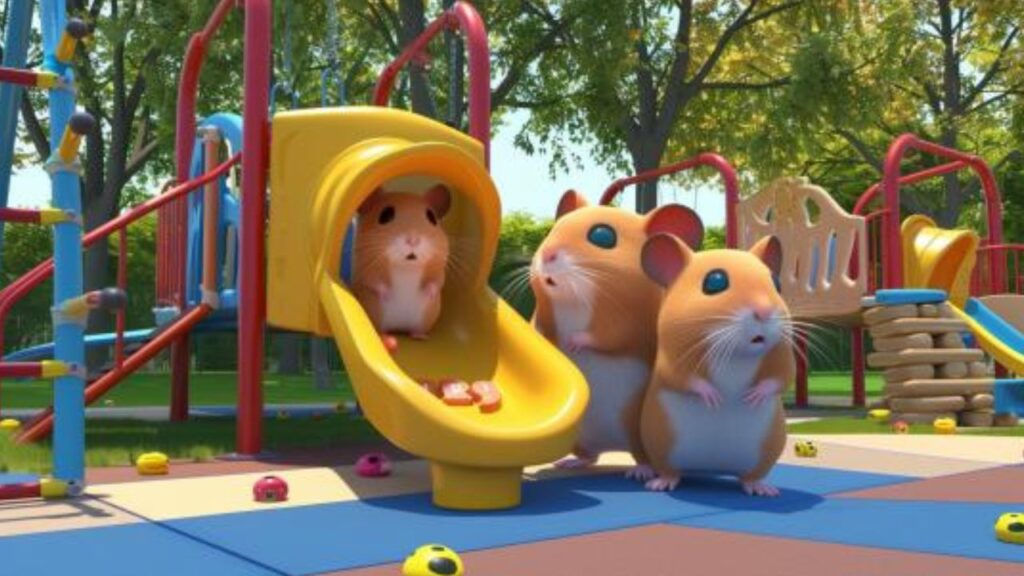Water is the elixir of life—not just for humans but for our tiny hamster friends, too. Despite their small size, hamsters rely on proper hydration to stay active, healthy, and happy. From powering their digestion to maintaining their body temperature, water is essential for their overall well-being. However, it’s not uncommon for hamster owners to wonder how much water their pet really needs, especially since these animals originated from arid environments.
Understanding your hamster’s hydration needs is a crucial part of providing proper care. Dehydration can lead to serious health problems, while consistent access to clean water helps prevent illness and keeps your furry companion thriving. In this article, we’ll dive into the fascinating science behind hamster hydration, explore how much water they need, and share tips for ensuring your hamster stays hydrated and healthy.
Overview of the Importance of Water for Hamsters
Water is vital for nearly every function in a hamster’s body. Just like humans, hamsters rely on water to:
- Digest food properly.
- Circulate nutrients through their bloodstream.
- Regulate their body temperature.
- Flush toxins from their system.
Without enough water, a hamster’s body quickly becomes unbalanced. Dehydration can cause lethargy, poor appetite, and, in severe cases, organ damage or even death. For such small animals, even a short period without access to water can lead to serious consequences.
Although hamsters are desert-adapted creatures and can survive on small amounts of water in the wild, domesticated hamsters have different needs. They depend on their owners to provide a consistent supply of fresh, clean water to stay hydrated and healthy.
Why Understanding Hydration Is Essential for Their Health
Hydration doesn’t just prevent dehydration—it directly impacts your hamster’s quality of life. A well-hydrated hamster will be more active, curious, and playful, while a dehydrated hamster may become lethargic and stressed. Even subtle changes in water intake can be an early warning sign of illness, so monitoring their hydration habits is a vital part of pet care.
Understanding hydration also helps you tailor your hamster’s diet and habitat to meet their needs. For example, did you know that offering water-rich treats like cucumber can supplement their hydration, or that environmental factors like room temperature can influence how much water they drink? These small but important details can make a big difference in their well-being.
Teaser for What the Article Will Cover
In this article, we’ll explore everything you need to know about hamster hydration, including:
- How much water your hamster really needs each day.
- Signs of dehydration and what to do if your hamster isn’t drinking enough.
- The best ways to provide water, including tips for choosing between water bottles and bowls.
- How diet and hydration are connected and which foods can help keep your hamster hydrated.
By the end, you’ll have all the tools and knowledge you need to ensure your hamster stays hydrated, healthy, and happy. Let’s dive into the science of hamster hydration and learn how to give your little buddy the care they deserve!
Why Hydration Is Essential for Hamsters
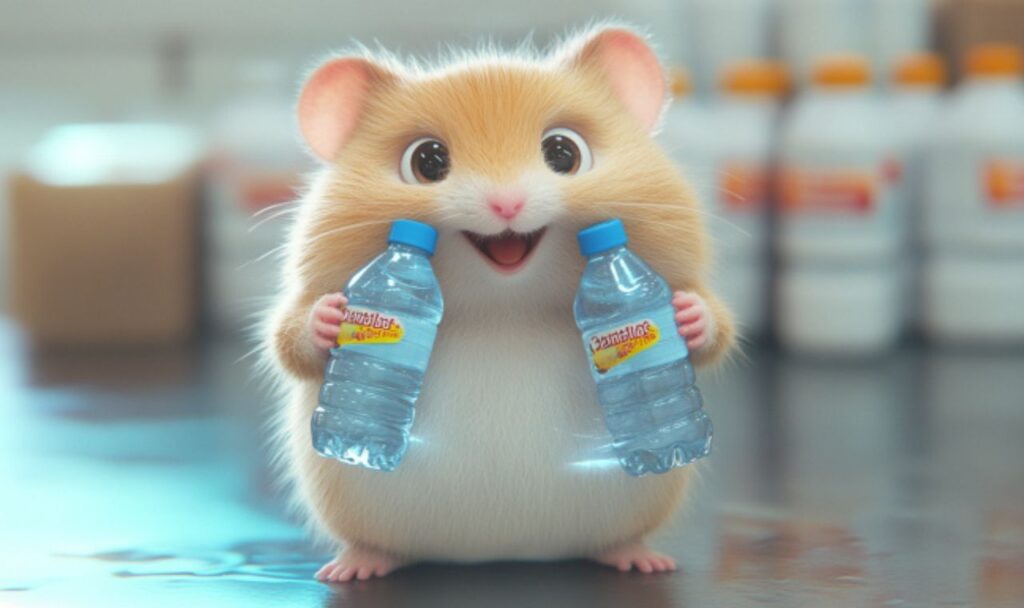
Water is more than just a thirst-quencher—it’s the foundation of life for every living creature, including hamsters. Proper hydration plays a critical role in a hamster’s health, supporting everything from digestion to circulation. Although hamsters are naturally hardy creatures that can survive in dry environments, domesticated hamsters require a reliable source of water to thrive. Let’s dive into why hydration is so vital for your furry friend and how to spot and prevent dehydration before it becomes a serious issue.
The Role of Water in a Hamster’s Body
How Water Supports Bodily Functions Like Digestion and Circulation
Water is essential for nearly every biological process in a hamster’s body. It helps break down food during digestion, allowing nutrients to be absorbed and distributed throughout the body. Water also keeps their blood flowing smoothly, ensuring oxygen and nutrients reach every cell and organ. Additionally, it aids in waste removal by flushing toxins from their system and maintaining kidney function.
Hamsters have fast metabolisms, so they rely on consistent hydration to keep all these processes running efficiently. Without adequate water, their bodily functions can quickly become unbalanced, leading to health complications.
Why Dehydration Can Lead to Health Problems
When a hamster doesn’t get enough water, their body starts to prioritize survival, shutting down less critical processes. Over time, dehydration can result in:
- Digestive Issues: Without enough water, food cannot be properly broken down, leading to constipation or digestive blockages.
- Lethargy: Dehydration reduces circulation and energy levels, causing your hamster to feel weak and tired.
- Kidney Damage: Hamsters need water to eliminate waste effectively. Dehydration can cause the buildup of toxins, which may lead to kidney problems or urinary issues.
In severe cases, dehydration can lead to organ failure and death, making it essential to ensure your hamster has constant access to clean water.
Fun Fact: Hamsters in the Wild Get Water from Surprising Sources!
In the wild, hamsters live in arid, desert-like regions where water is scarce. So how do they stay hydrated? Instead of relying solely on drinking water, wild hamsters obtain moisture from the foods they eat, such as seeds, roots, and occasional fruits. Their ability to extract water from food is a remarkable adaptation to their natural environment.
However, domesticated hamsters still need fresh water daily because their diet (typically dry food mixes) doesn’t provide the same level of hydration. While small amounts of water-rich treats like cucumber can help, fresh drinking water remains their primary source of hydration.
Signs of Dehydration in Hamsters
Behavioral Signs (Lethargy, Lack of Appetite)
A dehydrated hamster may become noticeably lethargic and less active than usual. You might find them sleeping more, moving slowly, or avoiding their exercise wheel. Another red flag is a lack of appetite—since hamsters rely on water for proper digestion, dehydration often leads to a reduced interest in food.
If your hamster appears unusually tired or is skipping meals, dehydration could be the underlying cause.
Physical Signs (Sunken Eyes, Dry Skin)
In addition to behavioral changes, dehydration causes visible physical symptoms, such as:
- Sunken Eyes: Dehydration reduces fluid levels in the body, causing the eyes to appear hollow or sunken.
- Dry Skin: Gently pinch the loose skin on your hamster’s scruff (the back of their neck). If the skin doesn’t bounce back quickly, it’s a sign of dehydration.
Other symptoms may include a dry nose or gums, which indicate that your hamster’s body is lacking necessary fluids.
Why Catching Dehydration Early Is Critical
Hamsters are small animals with high metabolic rates, meaning dehydration can progress quickly. If left untreated, it can escalate to life-threatening complications. That’s why it’s critical to recognize the early warning signs and take immediate action. Providing water, hydrating treats, or seeking veterinary advice can make all the difference in your hamster’s recovery.
Common Causes of Dehydration
Environmental Factors Like Heat or Low Humidity
Hamsters are sensitive to their environment, and extreme temperatures can cause dehydration. Hot or humid conditions increase water loss through evaporation, while dry air (common in winter due to indoor heating) can reduce their ability to retain moisture. Always keep your hamster’s cage in a temperature-controlled area, away from direct sunlight or drafts.
Dirty or Blocked Water Bottles
A water bottle that’s dirty, blocked, or malfunctioning is one of the most common causes of dehydration in hamsters. If the spout becomes clogged or the bottle leaks, your hamster may be unable to access water when they need it. Similarly, a dirty water bottle can deter your hamster from drinking due to unpleasant odors or tastes.
To prevent this, check the water bottle daily to ensure it’s functioning properly and clean it thoroughly at least once a week.
Illness or Diet Imbalances That Increase Water Loss
Certain health conditions, such as diarrhea or kidney problems, can cause a hamster to lose water more rapidly than usual. Similarly, a diet that consists primarily of dry food with little fresh produce can lead to increased thirst or dehydration. If you notice your hamster drinking more or less water than usual, it’s worth consulting a veterinarian to rule out underlying health issues.
How Much Water Does a Hamster Really Need?

One of the most common questions hamster owners ask is, “How much water does my hamster actually need?” While hamsters are small animals, water is still essential for their survival and well-being. However, their hydration needs can vary based on factors like species, diet, environment, and activity level. Understanding these factors can help you ensure your furry friend gets just the right amount of water to stay healthy and hydrated. Let’s explore the science of hamster hydration and uncover the truth about how much water they truly need.
Daily Water Intake for Hamsters
Average Water Requirements (Based on Species and Size)
On average, hamsters drink about 10-30 milliliters of water per day, depending on their species, size, and individual needs. Here’s a rough breakdown:
- Syrian Hamsters: These larger hamsters typically need closer to 20-30 milliliters of water per day.
- Dwarf Hamsters (e.g., Roborovski, Campbell’s, Winter White): Smaller species like dwarf hamsters require less water, averaging around 10-20 milliliters per day.
It’s important to note that these are averages. Your hamster’s specific water intake may vary slightly based on their diet, activity, and environment.
How Age and Activity Level Impact Hydration Needs
A hamster’s age plays a role in how much water they consume. Young hamsters tend to drink less than adults because they’re smaller and require less fluid to sustain their bodies. On the other hand, pregnant or nursing female hamsters often drink more water to support the needs of their babies.
Activity level also has an impact. A particularly active hamster that spends hours running on their wheel may drink more water to compensate for the fluids lost during physical activity. It’s always a good idea to monitor your hamster’s water intake and adjust as needed based on their behavior and life stage.
Do Dwarf Hamsters Need Less Water Than Syrians?
Yes, dwarf hamsters generally need less water than their larger Syrian counterparts, simply because of their smaller size. However, their hydration needs are still significant relative to their body weight. Just because they drink less doesn’t mean they can go without water for long periods—dwarf hamsters, like all hamsters, need constant access to fresh water to stay healthy.
Factors That Affect Water Consumption
Diet: Dry Food vs. Fresh Vegetables
A hamster’s diet is one of the biggest factors influencing their water needs. Hamsters fed primarily dry foods, like pellets or seed mixes, will drink more water to compensate for the lack of moisture in their diet. On the other hand, hamsters that are regularly offered water-rich foods like cucumber, celery, or lettuce may drink slightly less from their water bottle.
While fresh vegetables are a great way to supplement hydration, they shouldn’t replace water entirely. Always provide a constant source of clean drinking water, even if you’re offering water-rich treats.
Climate: Effects of Temperature and Humidity on Thirst
The temperature and humidity in your home can significantly affect your hamster’s water consumption. In warmer climates or during the summer months, hamsters may drink more water to stay cool and prevent dehydration. Conversely, in cold or dry winter conditions (especially when indoor heating is used), they might drink more to combat the dryness in the air.
To help your hamster stay hydrated in any climate, make sure their cage is placed in a stable environment with moderate temperature and humidity levels.
Activity: How Active Hamsters May Drink More
Just like humans, hamsters that are more active will need more water to stay hydrated. If your hamster spends a lot of time running on their wheel, climbing, or exploring, they’ll naturally require extra hydration to make up for the fluids they lose through physical activity.
If you notice your hamster drinking more water after a particularly energetic evening, it’s completely normal. Just make sure their water bottle or bowl is always full so they can rehydrate as needed.
Myth-Busting: Hamsters and “Desert Animals”
Addressing the Misconception That Hamsters Need Very Little Water
Many people assume that because hamsters originated in dry, desert-like regions, they need very little water. While it’s true that wild hamsters are adapted to arid environments, this doesn’t mean they don’t require hydration. In fact, water is just as critical to a hamster’s survival as it is for any other animal.
Wild hamsters get much of their moisture from the foods they forage, such as seeds, roots, and occasional fruits. However, domesticated hamsters rely on their owners to provide fresh drinking water daily, as their diet (mainly dry food) doesn’t naturally provide enough hydration.
How Domesticated Hamsters Differ from Their Wild Counterparts
Domesticated hamsters have different lifestyles and diets than their wild relatives. In captivity, they’re more dependent on humans to meet their needs. While wild hamsters might survive on the moisture from seeds or plants, a domesticated hamster fed primarily pellets and seeds needs access to water to avoid dehydration.
Additionally, domesticated hamsters are less likely to face the harsh survival challenges of the wild, so their hydration habits have adapted accordingly. Simply put, your hamster relies on you to make water readily available.
Why Even Desert Animals Still Need Consistent Hydration
Even desert animals, like camels or wild hamsters, need consistent hydration to survive. Their ability to go without water for longer periods is simply an adaptation for survival, not an indication that they don’t need water at all. In fact, prolonged dehydration can still cause serious harm, even to animals with desert adaptations.
For your domesticated hamster, consistency is key. Always ensure they have fresh, clean water to drink, regardless of how much or how little they seem to consume.
The Best Way to Provide Water for Hamsters
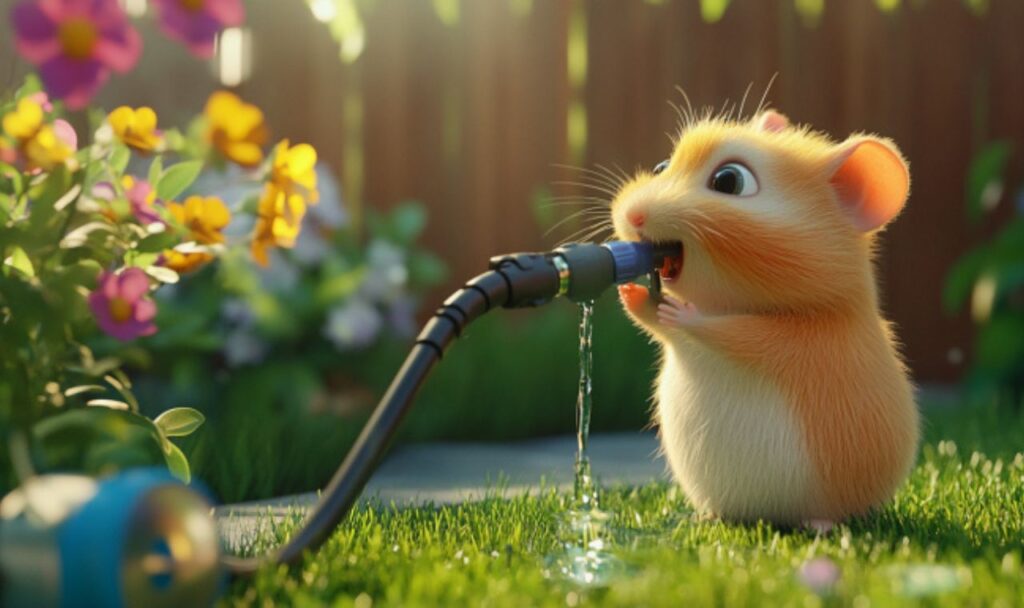
When it comes to keeping your hamster hydrated, providing a consistent source of clean water is non-negotiable. However, as a pet owner, you might wonder: is a water bottle or a bowl the better option? How can you ensure your hamster always has access to fresh water, and how can you monitor their drinking habits? In this section, I’ll share the best ways to provide water for your hamster, ensuring their hydration needs are met with convenience and care.
Water Bottles vs. Water Bowls
Pros and Cons of Each Option
Choosing between a water bottle and a water bowl depends on your hamster’s needs, your cage setup, and your personal preferences. Let’s break it down:
Water Bottles:
- Pros:
- Keeps water clean and uncontaminated by bedding or droppings.
- Easy to attach to most cages.
- Reduces the risk of spills, keeping the cage dry.
- Cons:
- Can malfunction or leak if not properly maintained.
- May be harder for some hamsters to use, especially if the nozzle is stiff or positioned incorrectly.
Water Bowls:
- Pros:
- Easier for hamsters to access, especially for young, elderly, or sick hamsters.
- Natural drinking posture mimics how hamsters would drink in the wild.
- Cons:
- Can be easily tipped over, causing spills.
- Water may become contaminated with bedding, droppings, or food.
While both options can work, water bottles are generally preferred for most hamsters because they keep water cleaner for longer. However, some owners like to offer both, ensuring their hamster always has access to water in a way that’s comfortable for them.
How to Choose the Right Water Bottle for Your Hamster
If you opt for a water bottle, choose one that suits your hamster’s size and cage type. Look for:
- Hamster-Sized Nozzles: Make sure the nozzle is appropriately sized for your hamster’s small mouth. Bottles designed for rabbits or guinea pigs are too large for hamsters.
- Drip-Free Design: Choose a water bottle with an anti-leak mechanism to prevent puddles forming in the cage.
- Easy Attachment: Ensure the bottle can be securely attached to your hamster’s cage at the right height—just above their bedding and easily reachable without stretching.
Once you’ve chosen a bottle, observe your hamster to ensure they know how to use it. Some hamsters may need encouragement or training to figure out how to drink from the nozzle.
Tips for Cleaning and Maintaining Water Dispensers
Water bottles and bowls need regular cleaning to prevent the buildup of bacteria, algae, or mineral deposits. Here’s how to keep them clean:
- Daily Rinse: Empty and rinse your hamster’s water dispenser with warm water every day.
- Weekly Deep Clean: Once a week, use a bottle brush or small sponge to scrub the inside of the water bottle or bowl. A small amount of pet-safe soap can be used, but rinse thoroughly to avoid leaving any residue.
- Check for Functionality: Test the bottle nozzle daily to ensure water flows freely when your hamster licks it. Clogs or blockages can deprive your hamster of water.
Regular cleaning not only ensures your hamster always has clean water but also prevents health issues caused by bacteria or contamination.
Ensuring Access to Clean Water
The Importance of Fresh, Clean Water Every Day
Hamsters need access to fresh, clean water 24/7. Even short periods without water can cause dehydration, which can lead to serious health issues. Old or stagnant water can also harbor bacteria, making your hamster reluctant to drink or causing illness.
To keep your hamster healthy and hydrated, make it a daily habit to check their water and replace it with fresh, clean water—ideally filtered or dechlorinated tap water.
How Often to Check and Refill Water Bottles
Check your hamster’s water bottle at least twice a day to ensure it’s full, functional, and free from leaks. Hamsters don’t drink large amounts of water, so you might not notice much change in the water level from day to day—but it’s still important to check!
Even if the bottle looks full, refill it with fresh water daily to ensure it’s clean and free of bacteria. If you’re using a water bowl, you may need to refill it more frequently, especially if it becomes contaminated with bedding or food.
Preventing Contamination from Bedding or Droppings
If you’re using a water bowl, place it on a stable surface that’s slightly elevated to minimize the risk of bedding or droppings falling into the water. Some owners like to use ceramic bowls, as they’re harder for hamsters to tip over.
For water bottles, ensure the nozzle is positioned above the bedding to prevent leaks or contamination.
Monitoring Water Consumption
How to Track How Much Your Hamster Is Drinking
Monitoring your hamster’s water intake is an important part of keeping them healthy. To track their drinking habits:
- Mark the water level on the outside of the bottle each time you refill it. This will give you a clear idea of how much your hamster is drinking over time.
- Observe their behavior—are they visiting the water bottle or bowl frequently? Or does it seem like they’re ignoring it?
Every hamster has unique drinking habits, but significant changes in water intake should be noted and investigated.
When to Be Concerned About Increased or Decreased Water Intake
If your hamster suddenly starts drinking more or less water than usual, it could signal an underlying issue:
- Increased Water Intake: This could be a sign of diabetes (especially in dwarf hamsters, who are prone to the condition) or kidney problems.
- Decreased Water Intake: If your hamster isn’t drinking enough, they could be dehydrated or ill. Check for blockages in their water dispenser and consult a vet if their drinking habits don’t improve.
Always monitor for other symptoms, such as lethargy, weight loss, or changes in appetite, as these can provide clues about your hamster’s health.
Tips for Encouraging a Reluctant Drinker
If your hamster isn’t drinking enough water, try the following:
- Check the Water Bottle: Ensure the nozzle isn’t blocked and that water flows freely.
- Adjust the Bottle Height: Make sure the bottle is positioned at a comfortable height for your hamster to reach.
- Offer Water-Rich Foods: Provide small amounts of water-rich treats, such as cucumber or lettuce, to supplement their hydration.
- Switch to a Bowl: If your hamster struggles with a water bottle, try offering water in a shallow, stable bowl.
If your hamster continues to avoid drinking, consult a veterinarian to rule out any underlying health issues.
The Relationship Between Diet and Hydration

Did you know that what your hamster eats has a significant impact on their hydration? While water bottles or bowls are the primary source of hydration for hamsters, their diet can either help maintain proper water levels or contribute to dehydration. Understanding the connection between diet and hydration will help you ensure your hamster stays healthy, happy, and well-balanced. Let’s dive into which foods boost hydration, which ones to avoid, and how commercial food mixes factor into the equation.
Water-Rich Foods Hamsters Can Safely Eat
Safe Vegetables and Fruits That Boost Hydration
Incorporating water-rich foods into your hamster’s diet is a great way to supplement their hydration while also providing variety and enrichment. Safe, hydrating options include:
- Vegetables: Cucumber, zucchini, celery, lettuce (in small amounts), broccoli, and bell peppers.
- Fruits (in moderation): Watermelon (seedless), apple (seedless), blueberries, and strawberries.
These foods not only provide moisture but also contain vitamins and minerals that support your hamster’s overall health. However, always introduce new foods gradually to avoid upsetting their sensitive digestive systems.
Portion Control to Prevent Digestive Issues
While water-rich foods are healthy, portion control is essential. Overfeeding fresh vegetables or fruits can cause diarrhea, which leads to dehydration—the very thing you’re trying to prevent! Stick to small portions, such as a quarter-sized piece of cucumber or a tiny blueberry, and offer fresh foods no more than 2-3 times per week.
Remember, moderation is key. Fresh produce should be treated as a supplement to their main diet, not a replacement for it.
Why Balance Is Key: Treats vs. Main Diet
It’s easy to get carried away offering your hamster tasty treats, but balance is crucial. Hydrating foods should complement, not overshadow, their primary diet of pellets or seed mixes. While fresh produce is hydrating, it doesn’t provide all the nutrients your hamster needs. An unbalanced diet can lead to health issues, including obesity or nutrient deficiencies.
Aim for a diet that’s 80-90% high-quality commercial food and 10-20% treats like fresh vegetables, fruits, or small protein sources. This balance ensures your hamster gets adequate hydration while maintaining proper nutrition.
Foods That Can Cause Dehydration
Salty or Sugary Treats to Avoid
Certain foods can actually dehydrate your hamster by disrupting their body’s water balance. Avoid feeding your hamster:
- Salty Foods: Chips, crackers, or salted nuts, as salt can cause excessive thirst and strain their kidneys.
- Sugary Foods: Candies, cookies, or any processed human sweets, as sugar can lead to energy spikes, weight gain, and dehydration.
- Seasoned Foods: Spices, marinades, or flavored foods are harmful and can lead to dehydration or toxicity.
Stick to hamster-safe treats and avoid giving them anything that contains added salt, sugar, or artificial flavors.
Why Processed Human Foods Can Disrupt Hydration Levels
Processed human foods are packed with ingredients that hamsters’ bodies simply aren’t built to handle. Salt, sugar, and preservatives can upset their natural hydration levels, forcing their bodies to use more water to process these substances. In turn, this can lead to dehydration and other health issues like obesity or digestive problems.
If you want to offer treats, stick to natural, hamster-safe options like a small piece of carrot or a plain, unsalted pumpkin seed.
The Role of Fiber in Maintaining Proper Hydration
Fiber is an often-overlooked factor in hydration. A high-fiber diet helps maintain digestive health and prevents issues like diarrhea, which can lead to water loss. Fiber also helps regulate water absorption in the intestines, ensuring your hamster stays properly hydrated.
Good sources of fiber include fresh leafy greens (like spinach or kale), small amounts of oats, or commercial hamster pellets designed for balanced nutrition.
The Role of Commercial Food Mixes
How Pellets and Seed Mixes Affect Hydration
Pellets and seed mixes form the foundation of a hamster’s diet, but they’re typically dry and low in water content. While these foods provide essential nutrients, they don’t contribute much to your hamster’s daily hydration. As a result, hamsters on a dry-only diet need to drink more water from their water bottle to stay hydrated.
Dry foods are perfectly fine as the main diet but must be supplemented with fresh water and occasional water-rich treats to maintain proper hydration levels.
Why a Dry-Only Diet Increases Water Needs
If your hamster is eating a diet consisting solely of pellets or seeds, their water needs will naturally increase to compensate for the lack of moisture in their food. This is why it’s so important to ensure their water bottle or bowl is always full and clean—hamsters on a dry diet depend on it even more.
Monitor their water bottle daily, and if you notice that your hamster drinks more than usual, consider adding small amounts of fresh produce to their diet to provide some hydration through food.
Tips for Supplementing a Dry Diet with Fresh Foods
To balance the dryness of commercial food mixes, offer your hamster small portions of fresh vegetables or fruits a few times a week. Here are some tips for supplementing their diet:
- Rotate Fresh Foods: Offer a variety of hydrating treats to keep your hamster’s meals exciting while providing different nutrients. For example, rotate between cucumber, apple, and bell pepper.
- Wash Thoroughly: Rinse all fruits and vegetables thoroughly to remove any pesticides or chemicals before serving.
- Avoid Overfeeding: Stick to tiny portions—about the size of a hamster’s paw—to prevent digestive upset.
By combining a balanced commercial mix with fresh, hydrating foods, you’ll ensure your hamster stays both nourished and well-hydrated.
Hydration Tips for Hamster Owners

Proper hydration is essential for keeping your hamster healthy, but different seasons, cage setups, and even your hamster’s habits can impact how much water they drink. To ensure your furry friend stays hydrated year-round, you’ll need to adapt to seasonal changes, create a hydration-friendly habitat, and address any issues if they stop drinking. Below are practical tips to keep your hamster hydrated and happy no matter the circumstances!
Adapting to Seasonal Changes
Hamsters’ hydration needs can fluctuate with the seasons, especially as temperatures rise or drop. By making small adjustments to their care routine, you can help them stay hydrated and comfortable year-round.
How to Keep Your Hamster Hydrated in Hot Weather
Hot weather can increase your hamster’s risk of dehydration, as they may lose water more quickly due to heat. Here’s how to prevent dehydration during the summer:
- Fresh Water Always: Refill their water bottle daily with cool, fresh water. Check it more frequently, as hamsters may drink more in the heat.
- Provide Water-Rich Treats: Add hydrating snacks like cucumber, watermelon (seedless), or zucchini to their diet to give them a refreshing moisture boost.
- Cool Their Environment: Place the cage in a cool, shaded area away from direct sunlight. You can even add a ceramic tile or chilled sand bath to give them a cool surface to rest on.
By providing these small comforts, you can keep your hamster cool, hydrated, and stress-free during hot weather.
Tips for Maintaining Hydration During Winter (e.g., Dry Air from Heaters)
In winter, heaters and indoor heating systems can dry out the air, making it harder for hamsters to retain moisture. Here’s how to combat the effects of dry winter air:
- Humidify the Room: If the air in your home is very dry, consider using a humidifier in the room where your hamster’s cage is located.
- Check Water Bottles More Often: Water bottles can freeze in very cold rooms or evaporate more quickly in heated spaces. Make sure your hamster’s water supply is always available.
- Offer Fresh Vegetables: Hydrating vegetables like broccoli or celery are a great way to supplement their water intake during winter.
Pay attention to your hamster’s behavior in winter—if they seem lethargic or drink less, adjust their environment accordingly.
Adjusting Diet and Water Placement Based on Seasonal Needs
Seasonal changes may also require small tweaks to your hamster’s diet and cage setup:
- Diet Adjustments: Increase water-rich treats during hot weather and offer small amounts during winter for hydration without overloading their digestive system.
- Water Placement: Place their water bottle in an easily accessible location. During hot weather, keep it out of direct sunlight to prevent the water from warming up.
By making these small seasonal adjustments, you’ll help your hamster stay hydrated no matter the time of year.
Creating a Hydration-Friendly Habitat
Your hamster’s environment plays a significant role in their ability to stay hydrated. A hydration-friendly habitat ensures they always have easy access to water and remain comfortable in their cage.
Cage Placement: Avoiding Direct Sunlight and Drafty Areas
Where you place your hamster’s cage matters! To create a hydration-friendly setup:
- Avoid Direct Sunlight: Never place the cage near a window or in direct sunlight, as this can cause overheating and water evaporation.
- Avoid Drafty Areas: Drafts can lower the temperature and make your hamster uncomfortable, especially in winter. Place the cage in a stable environment away from doors, vents, or windows.
- Choose a Quiet, Stable Room: Loud noises and constant activity can stress hamsters, potentially reducing their appetite and water intake.
A stable and comfortable cage placement promotes not only hydration but overall well-being.
Adding Water-Rich Treats as a Hydration Boost
Supplementing your hamster’s diet with hydrating treats like cucumber, lettuce, or watermelon can provide an extra hydration boost. Just make sure to:
- Offer treats in moderation to avoid digestive upset.
- Remove uneaten fresh food within a few hours to prevent spoilage.
This added moisture can be especially beneficial during hot weather or if your hamster doesn’t seem to drink enough from their water bottle.
Ensuring Easy Access to Water for All Cage Setups
No matter how your hamster’s cage is arranged, they should always have easy access to their water source. Here’s how to ensure this:
- Place Water Bottles Correctly: Attach the water bottle at a height that’s easy for your hamster to reach without stretching or straining. The nozzle should be positioned just above their bedding.
- Use a Stable Water Bowl (If Preferred): If you use a bowl, choose a heavy, stable ceramic dish to prevent tipping. Place it slightly elevated to avoid bedding contamination.
Check their water source daily to ensure it’s functioning properly and is easy for them to access.
What to Do If Your Hamster Refuses to Drink
It can be alarming if your hamster suddenly stops drinking water. Here’s how to address the issue and encourage them to drink again.
Identifying the Cause of Low Water Intake
If your hamster isn’t drinking, first identify potential reasons:
- Blocked Water Bottle: The nozzle may be clogged, preventing water from flowing. Test the bottle to ensure water comes out easily.
- Unclean Water: Hamsters may avoid drinking if the water is dirty or has an unpleasant taste. Always provide fresh, clean water.
- Stress or Illness: Illness, injury, or stress can reduce your hamster’s appetite and water intake. Check for other symptoms like lethargy, weight loss, or changes in behavior.
Identifying the root cause can help you take the right steps to resolve the issue.
Practical Steps to Encourage Drinking (e.g., Flavored Water Tricks)
If your hamster is reluctant to drink, try these tips:
- Offer Water-Rich Foods: Small amounts of hydrating vegetables like cucumber or celery can help supplement their water intake.
- Flavored Water Trick: Add a tiny drop of fruit juice (such as apple juice) to their water to make it more appealing. Make sure the juice is unsweetened and diluted.
- Switch to a Bowl: If your hamster doesn’t seem to like their water bottle, offer water in a shallow dish or bowl to see if they prefer it.
Always monitor their water intake closely when trying these methods and switch back to plain water once they start drinking regularly again.
When to Consult a Vet for Dehydration Concerns
If your hamster continues to refuse water or shows signs of dehydration—such as lethargy, sunken eyes, dry skin, or lack of appetite—it’s time to consult a veterinarian. Dehydration can escalate quickly and lead to serious health issues, so seeking professional help is crucial if your hamster isn’t improving.
Conclusion: A Well-Hydrated Hamster is a Healthy Hamster
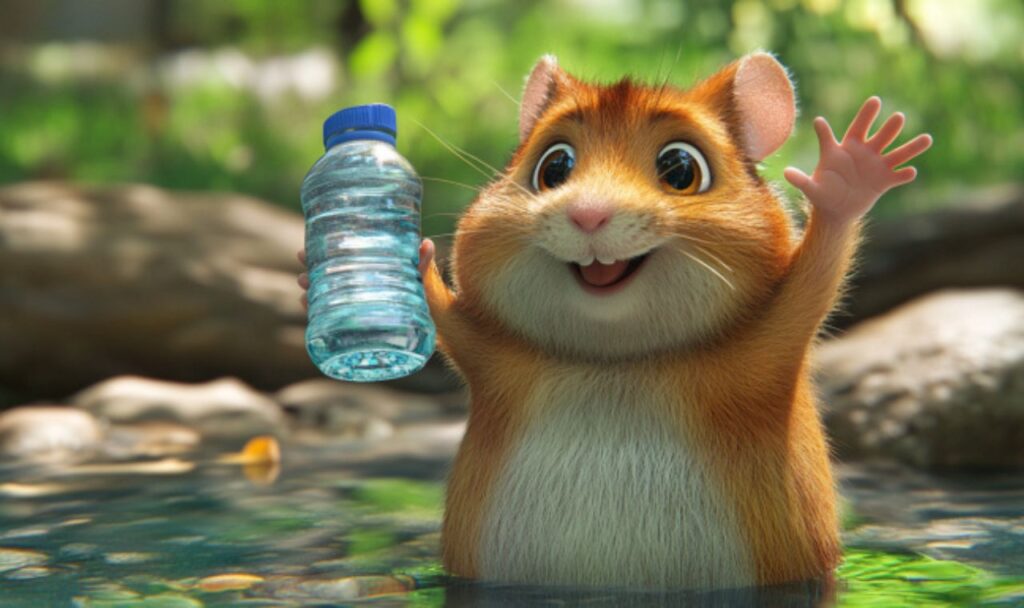
Water is life—this applies not only to us but to our tiny, whiskered companions as well! Ensuring your hamster is properly hydrated is one of the simplest yet most important ways to keep them healthy, happy, and full of energy. While hamsters may seem low-maintenance at first glance, their water needs deserve careful attention. By understanding their hydration requirements, providing clean water consistently, and supplementing their diet with hydrating treats, you’ll give your furry friend the best chance to thrive.
Recap of Key Points About Hydration and Water Needs
Throughout this article, we’ve explored every aspect of hamster hydration, from their daily water needs to tips for keeping them hydrated year-round. Let’s quickly recap the key takeaways:
- Water’s Role in Health: Water is critical for digestion, circulation, temperature regulation, and waste elimination. Even a small amount of dehydration can lead to significant health problems for your hamster.
- Daily Water Intake: On average, hamsters need 10-30 milliliters of water per day, depending on their species, size, and activity level. Dwarf hamsters generally need less water than Syrians but still require constant access to it.
- Seasonal Changes: Hydration needs may increase in hot weather, while winter’s dry air can also make proper hydration more challenging. Adapting your hamster’s care to seasonal conditions is essential.
- Hydrating Foods: Water-rich vegetables and fruits, such as cucumber and celery, can boost hydration while adding variety to your hamster’s diet. However, moderation is key to avoid digestive upset.
- Creating a Hydration-Friendly Habitat: Keep their cage in a stable, shaded location away from direct sunlight, drafts, or temperature extremes. Ensure their water dispenser is always clean, accessible, and functioning properly.
- Monitoring Drinking Habits: Sudden changes in water intake, whether it’s too much or too little, may signal health issues and should be addressed promptly.
By implementing these tips, you can ensure your hamster has everything they need to stay hydrated and healthy.
Why Hydration is Essential to Your Hamster’s Overall Health and Happiness
Water is the foundation of your hamster’s health—it keeps their tiny body functioning properly and helps prevent a wide range of issues, from lethargy to kidney problems. Proper hydration supports their energy levels, encourages natural behaviors like foraging and playing, and strengthens their overall immune system.
A well-hydrated hamster is also a happier hamster. When they’re properly cared for, they’ll be more active, curious, and playful, which makes their time with you even more enjoyable. Remember, dehydration can set in quickly for small animals, so providing fresh water daily is critical for their well-being.
Encouragement to Monitor Water and Diet for a Thriving, Active Pet
As a responsible hamster owner, one of the best things you can do is monitor your hamster’s water and diet regularly.
- Check their water bottle or bowl every day to ensure it’s full, clean, and accessible.
- Incorporate small portions of water-rich, hamster-safe foods into their diet for added hydration and enrichment.
- Keep an eye on their drinking habits—any noticeable changes could be an early warning sign of dehydration or illness.
Caring for your hamster’s hydration doesn’t have to be complicated, but it does require consistency and attention. By making hydration a priority, you’ll give your hamster the foundation they need to live a long, happy, and active life.
Let’s raise our water bottles (or bowls) to good hydration and healthy hamsters!

